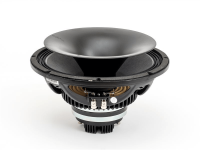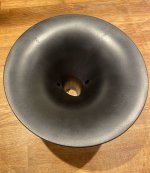Hi Guys,
I've been looking at this Eighteen sound 12NCX750H (link below) coaxial driver and it comes with this horn, on the website its stated as a 'curvilinear profile LF cone'.
I'm a bit confused as this isn't a traditional horn profile I've come across in my research, e.g. exponential, oblate spheroid or le cleach.
Also I'm also thrown off by the circular profile (viewed from the front, I've attached a photo) transitioning into elliptical profile transitioning back into a circular profile. The ellipsis looks like a pinch in the throat. The ellipsis must drive the 50deg and 70deg coverage angles, also printed on the horn.
Let me know your thoughts, thanks.
Link: https://www.eighteensound.it/en/products/coaxial/12-0/8/12NCX750H
I've been looking at this Eighteen sound 12NCX750H (link below) coaxial driver and it comes with this horn, on the website its stated as a 'curvilinear profile LF cone'.
I'm a bit confused as this isn't a traditional horn profile I've come across in my research, e.g. exponential, oblate spheroid or le cleach.
Also I'm also thrown off by the circular profile (viewed from the front, I've attached a photo) transitioning into elliptical profile transitioning back into a circular profile. The ellipsis looks like a pinch in the throat. The ellipsis must drive the 50deg and 70deg coverage angles, also printed on the horn.
Let me know your thoughts, thanks.
Link: https://www.eighteensound.it/en/products/coaxial/12-0/8/12NCX750H
Attachments
This seems to be referring to the woofer.'curvilinear profile LF cone'
As far as the waveguide, there's little space in a coax and one would expect the designer to get in and out as expeditiously and with as much control as possible.
Yes I see now how LF would be referring to Low frequency now. I can't really see any mention of the horn in the specification for the driver.
What do you mean by this? Are you suggesting that the horn isn't a traditional profile and is custom due to the geometric properties of the co-axial driver and how tight the space is? Is control in reference to directivity?
there's little space in a coax and one would expect the designer to get in and out as expediciously and with as much control as possible.
What do you mean by this? Are you suggesting that the horn isn't a traditional profile and is custom due to the geometric properties of the co-axial driver and how tight the space is? Is control in reference to directivity?
Yes and yes. For example if you look at it from the side it seems to be somewhat narrow. Narrow waveguides need to be larger than wider ones if they are to work down to the same frequencies, meaning that 90 degrees would have been a safer bet than 70 x 50..
I should really defer to the measurements before commenting.
I should really defer to the measurements before commenting.
In terms of narrow are you talking about the throat expansion, or directivity? If you see the second picture you can see two screw holes I've taken it off the driver from, I was assuming the consumer could rotate the horn if they wanted to change the directivity. You think this could be a better horn if it was uniform all the way round with a 90 degree directivity?
Also, I'm interested in remodelling this in CAD, how do you think I could go about determining the horn profile?
Also, I'm interested in remodelling this in CAD, how do you think I could go about determining the horn profile?
I've been looking at this Eighteen sound 12NCX750H (link below) coaxial driver and it comes with this horn, on the website its stated as a 'curvilinear profile LF cone'.
'curvilinear profile LF cone' though could be a horn profile if desired pg 58/46
Horn mouth polar frequency: c = 10^6/(a*b)Narrow waveguides need to be larger than wider ones if they are to work down to the same frequencies, meaning that 90 degrees would have been a safer bet than 70 x 50.
a = wall angle in deg
b = mouth width (or height) in inches
c = -6 dB frequency
metric = (2.54*10^6)/(a*b) in cm
I could make the same point using other profiles which have the same throat and mouth size, and length. The one with the smaller volume tends to be more narrow in the highs and to let go of the lows sooner.
Yes, but folks way before my time chose specific names for certain profiles, so seems 'we' don't want to 'muddy the waters' anymore than we have to already.
Fair enough, but I think this situation is unique. If I were normally to design a LeCleach I'd begin by finding the ideal dimensions and then move to fit them within the constraints.. whereas here the constraints are fixed and limiting to begin with, and the profile itself needs to become part of the compromise.
yea, I'm used to spherical, conical, tractrix, exponential.....
even constant directivity (with their yucky angles in the horn path causing reflections).
But OS (or peavey quadratic) seems like rounded at throat then conical.............
But that horn on top looks ok, but it looks like a tube at the throat then curving away, very limited hf dispersion to me.....
Link in 1st post lists dispersion as 70 x 50, well, many like a 90 x 40 for home, it limits ceiling bounce................
parts express lists dispersion as 60 x 40....
$600, qts .2 ? it loses 5db on an open baffle from 1khz down to 200hz, then falls off the cliff at 150hz..........
The hf horn response is scary also..........
https://www.parts-express.com/pedocs/specs/294-577--bc-12hcx76-spec-sheet.pdf
even constant directivity (with their yucky angles in the horn path causing reflections).
But OS (or peavey quadratic) seems like rounded at throat then conical.............
But that horn on top looks ok, but it looks like a tube at the throat then curving away, very limited hf dispersion to me.....
Link in 1st post lists dispersion as 70 x 50, well, many like a 90 x 40 for home, it limits ceiling bounce................
parts express lists dispersion as 60 x 40....
$600, qts .2 ? it loses 5db on an open baffle from 1khz down to 200hz, then falls off the cliff at 150hz..........
The hf horn response is scary also..........
https://www.parts-express.com/pedocs/specs/294-577--bc-12hcx76-spec-sheet.pdf
OK, I thought 'we' were just discussing curvilinear design, not try and fit a curvilinear horn inside a curvilinear woofer diaphragm.Fair enough, but I think this situation is unique. If I were normally to design a LeCleach I'd begin by finding the ideal dimensions and then move to fit them within the constraints.. whereas here the constraints are fixed and limiting to begin with, and the profile itself needs to become part of the compromise.
You rotate the driver to place the "70 degree directivity" in the orientation preferred. The throat is pinched narrower to cause slightly more diffraction to make the dispersion wider in the 70 degree orientation.In terms of narrow are you talking about the throat expansion, or directivity? If you see the second picture you can see two screw holes I've taken it off the driver from, I was assuming the consumer could rotate the horn if they wanted to change the directivity.
The directivity is rather uneven- the right hand being slightly more narrow :
A horn with uniform directivity would be preferable, but hard to achieve in the co-ax format.You think this could be a better horn if it was uniform all the way round with a 90 degree directivity?
Also, I'm interested in remodelling this in CAD, how do you think I could go about determining the horn profile?
The horn profile is different on each axis, not sure what you want to remodel it to.
Very weird response curves indeed, but the B&C is different coax from the OP's 18Sound 12NCX750H.The hf horn response is scary also..........
https://www.parts-express.com/pedocs/specs/294-577--bc-12hcx76-spec-sheet.pdf
- Home
- Loudspeakers
- Multi-Way
- Curvilinear horn profile - Is it a real thing?

